

Compare and contrast transition words for essays, discussions and more
When you are trying to compare and contrast different things, it helps to have the right words and phrases to explain your ideas clearly. This is where compare and contrast transition words come in handy.
A transition word or phrase guides the listener or reader through what the speaker or writer is saying. We use transition words, also known as ‘ discourse markers ‘, or ‘signal words’, to help us structure what we say and make our meaning clearer.
So, let’s take a look at some common transition words for comparing and contrasting – as well as some which you may not be familiar with. We have included plenty of example sentences so you can understand how to use them correctly.

Compare and contrast transition words
Comparing and contrasting involves explaining how one thing is the same as or different to something else, and examining alternatives. You may get a compare and contrast essay assignment, for example, or you might need to write a business plan exploring different possible outcomes.
Whatever the situation, these transition words for comparing and contrasting will help you transition from one point to the next in a clear and logical way.
Transition words for comparing similarities
When you want to highlight the similarities between two things, or talk about how they are the same, these are the comparison transition words you should use.
The following signal words can be used to compare two things in the same sentence:
“Cats are as friendly as dogs.” “That cloud looks like a face.” “I look similar to my mother.”
The next group of comparing words are used after one point has been stated or mentioned, and they begin the following sentence that contains the second point:
- in the same way
“The sales team need to work hard to meet their targets this month. Similarly , all warehouse staff must make an effort to despatch all orders on time.”
Find more examples of alternative words for ‘similarly’ here.
Transition words for contrast emphasis
When presenting something that contrasts with what was previously written or said, or what would be expected as a result of a previous point, we can use these contradictory transition words.
In a simple sentence when presenting the two pieces of information together, we can use:
“I’m really good at playing the guitar but I can’t play the flute.” “Alan is a great singer whereas Anna is an excellent painter.” “Spain is good for beach holidays, unlike Austria, which is good for skiing.”
To add information that contradicts or contrasts with what has previously been said in a separate sentence, we can use one of the following:
- in contrast
- on the contrary
- On the one hand… On the other hand
Here are some sentences with discourse markers to express contrast:
“Our children’s products have performed very well this year. Conversely , sales of menswear have fallen slightly.” “It’s been sunny today; however , I think it’s going to rain tomorrow.” “I’m not sure if we should continue working with this supplier. On the one hand , they have the best pricing in the market and a good reputation. On the other hand , we have had many problems with their service recently.”
Find some more emphasis transition words here.
Transition words to signal contrast in an outcome
When talking about one thing happening in spite of another thing (in contrast to the expected outcome), we can use transition words and phrases such as:
- all the same
- in spite of this
- nevertheless
- nonetheless
“The away team fought really hard to secure a victory. Still , the home team eventually won 2:1.” “I will try to pick up some groceries on the way home. All the same , it would be nice if you had time to do the shopping this afternoon.” “It has been a very tough year for the hospitality sector. In spite of this , our restaurant has managed to turn a good profit.”
In the same situation as above, but with the two points joined in the same sentence, you can use these signal words:
- in spite of
- even though
“ Even though the kids hadn’t met before, they got on really well at the party.” “We managed to afford a holiday despite our financial problems.” “We had a great time at the beach, in spite of the clouds.”
Find some more transition words for ending and concluding here.
Transition words for contrasting solutions and suggestions
And finally, these signal words can be used when you’re making a suggestion or offering a solution that contrasts with another suggestion or solution:
- alternatively
- another option is to
“ Instead of cooking dinner tonight, why don’t we get a takeaway?” “We could hire a new staff member for this project. Alternatively we could just use a consultant on a temporary basis.”
And that concludes this list of compare and contrast transition words. If you have any other examples or are unsure how to use these compare and contrast words in a sentence, please leave a comment below.
If you found this article useful, take a look at these others which cover different categories of transition word:
Transition words for addition Transition words for cause and effect Transition words for giving examples Transition words for time order and sequence
Finally, if you have a compare and contrast essay assignment, this resource might help you structure it well and cover the topic in full.
11 Comments
Is the word “while” one of the compare and contrast signal/transition words?
Yes, that’s another good one. ‘While’ is used in the same way as ‘whereas’ in the context of comparing and contrasting.
What about “other than”? Can it be considered a contrast and comparison word?
Good question! In some cases, yes, ‘other than’ could be used to contrast positive and negative points. For example: “Other than the broken taillight and faulty speedometer, this car is in perfect condition.”
Hi Amanda. Please help me with this.
He changed his mind about coming over even though we have prepared the meal and everything else for him.
I have a feeling the marker even though doesn’t quite work there. I’d like to emphasize the host great disappointment about the guest’s change of plan. Do you have another suggestion?
The sentence you proposed works well with ‘even though’. The only change you should make is to the tense, either:
“He changed his mind about coming over even though we had prepared the meal and everything else for him.” (reporting a past event)
“He has changed his mind about coming over even though we have prepared the meal and everything else for him.” (speaking about it as it happens).
An alternative would be to replace ‘even though’ with ‘despite the fact that’; that might hint at even stronger disappointment with the decision.
Hi Amanda, i want to ask you why ‘than’ is not part of signal words for comparison and contrast?
You’re right, this is an important word for comparing when paired with a comparative adjective.
Thank you Amanda, but i want to make sure gain that “than” is not a part of signal words in comparison and contrast, except “more than” or “less than”. Is that right?
You can use ‘than’ with any comparative adjective. For example, “Your dessert looks tastier than mine.” “This car is slower than when I bought it.” “Joshua is more intelligent than James.” I hope this helps!
Leave a Reply Cancel reply
Your email address will not be published. Required fields are marked *
Save my name, email, and site URL in my browser for next time I post a comment.
Sign me up for the newsletter!
5 Compare and Contrast Essay Examples (Full Text)

Chris Drew (PhD)
Dr. Chris Drew is the founder of the Helpful Professor. He holds a PhD in education and has published over 20 articles in scholarly journals. He is the former editor of the Journal of Learning Development in Higher Education. [Image Descriptor: Photo of Chris]
Learn about our Editorial Process
A compare and contrast essay selects two or more items that are critically analyzed to demonstrate their differences and similarities. Here is a template for you that provides the general structure:

A range of example essays is presented below.
Compare and Contrast Essay Examples
#1 jean piaget vs lev vygotsky essay.
1480 Words | 5 Pages | 10 References
(Level: University Undergraduate)

Thesis Statement: “This essay will critically examine and compare the developmental theories of Jean Piaget and Lev Vygotsky, focusing on their differing views on cognitive development in children and their influence on educational psychology, through an exploration of key concepts such as the role of culture and environment, scaffolding, equilibration, and their overall implications for educational practices..”
#2 Democracy vs Authoritarianism Essay

Thesis Statement: “The thesis of this analysis is that, despite the efficiency and control offered by authoritarian regimes, democratic systems, with their emphasis on individual freedoms, participatory governance, and social welfare, present a more balanced and ethically sound approach to governance, better aligned with the ideals of a just and progressive society.”
#3 Apples vs Oranges Essay
1190 Words | 5 Pages | 0 References
(Level: 4th Grade, 5th Grade, 6th Grade)

Thesis Statement: “While apples and oranges are both popular and nutritious fruits, they differ significantly in their taste profiles, nutritional benefits, cultural symbolism, and culinary applications.”
#4 Nature vs Nurture Essay
1525 Words | 5 Pages | 11 References
(Level: High School and College)

Thesis Statement: “The purpose of this essay is to examine and elucidate the complex and interconnected roles of genetic inheritance (nature) and environmental influences (nurture) in shaping human development across various domains such as physical traits, personality, behavior, intelligence, and abilities.”
#5 Dogs vs Cats Essay
1095 Words | 5 Pages | 7 Bibliographic Sources
(Level: 6th Grade, 7th Grade, 8th Grade)
Thesis Statement: “This essay explores the distinctive characteristics, emotional connections, and lifestyle considerations associated with owning dogs and cats, aiming to illuminate the unique joys and benefits each pet brings to their human companions.”
How to Write a Compare and Contrast Essay
I’ve recorded a full video for you on how to write a compare and contrast essay:
Get the Compare and Contrast Templates with AI Prompts Here
In the video, I outline the steps to writing your essay. Here they are explained below:
1. Essay Planning
First, I recommend using my compare and contrast worksheet, which acts like a Venn Diagram, walking you through the steps of comparing the similarities and differences of the concepts or items you’re comparing.
I recommend selecting 3-5 features that can be compared, as shown in the worksheet:

Grab the Worksheet as Part of the Compare and Contrast Essay Writing Pack
2. Writing the Essay
Once you’ve completed the worksheet, you’re ready to start writing. Go systematically through each feature you are comparing and discuss the similarities and differences, then make an evaluative statement after showing your depth of knowledge:

Get the Rest of the Premium Compare and Contrast Essay Writing Pack (With AI Prompts) Here
How to Write a Compare and Contrast Thesis Statement
Compare and contrast thesis statements can either:
- Remain neutral in an expository tone.
- Prosecute an argument about which of the items you’re comparing is overall best.
To write an argumentative thesis statement for a compare and contrast essay, try this AI Prompts:
💡 AI Prompt to Generate Ideas I am writing a compare and contrast essay that compares [Concept 1] and [Concept2]. Give me 5 potential single-sentence thesis statements that pass a reasonable judgement.
Ready to Write your Essay?

Take action! Choose one of the following options to start writing your compare and contrast essay now:
Read Next: Process Essay Examples

- Chris Drew (PhD) https://helpfulprofessor.com/author/chris-drew-phd-2/ 10 Reasons you’re Perpetually Single
- Chris Drew (PhD) https://helpfulprofessor.com/author/chris-drew-phd-2/ 20 Montessori Toddler Bedrooms (Design Inspiration)
- Chris Drew (PhD) https://helpfulprofessor.com/author/chris-drew-phd-2/ 21 Montessori Homeschool Setups
- Chris Drew (PhD) https://helpfulprofessor.com/author/chris-drew-phd-2/ 101 Hidden Talents Examples
Leave a Comment Cancel Reply
Your email address will not be published. Required fields are marked *

Comparing and Contrasting
What this handout is about.
This handout will help you first to determine whether a particular assignment is asking for comparison/contrast and then to generate a list of similarities and differences, decide which similarities and differences to focus on, and organize your paper so that it will be clear and effective. It will also explain how you can (and why you should) develop a thesis that goes beyond “Thing A and Thing B are similar in many ways but different in others.”
Introduction
In your career as a student, you’ll encounter many different kinds of writing assignments, each with its own requirements. One of the most common is the comparison/contrast essay, in which you focus on the ways in which certain things or ideas—usually two of them—are similar to (this is the comparison) and/or different from (this is the contrast) one another. By assigning such essays, your instructors are encouraging you to make connections between texts or ideas, engage in critical thinking, and go beyond mere description or summary to generate interesting analysis: when you reflect on similarities and differences, you gain a deeper understanding of the items you are comparing, their relationship to each other, and what is most important about them.
Recognizing comparison/contrast in assignments
Some assignments use words—like compare, contrast, similarities, and differences—that make it easy for you to see that they are asking you to compare and/or contrast. Here are a few hypothetical examples:
- Compare and contrast Frye’s and Bartky’s accounts of oppression.
- Compare WWI to WWII, identifying similarities in the causes, development, and outcomes of the wars.
- Contrast Wordsworth and Coleridge; what are the major differences in their poetry?
Notice that some topics ask only for comparison, others only for contrast, and others for both.
But it’s not always so easy to tell whether an assignment is asking you to include comparison/contrast. And in some cases, comparison/contrast is only part of the essay—you begin by comparing and/or contrasting two or more things and then use what you’ve learned to construct an argument or evaluation. Consider these examples, noticing the language that is used to ask for the comparison/contrast and whether the comparison/contrast is only one part of a larger assignment:
- Choose a particular idea or theme, such as romantic love, death, or nature, and consider how it is treated in two Romantic poems.
- How do the different authors we have studied so far define and describe oppression?
- Compare Frye’s and Bartky’s accounts of oppression. What does each imply about women’s collusion in their own oppression? Which is more accurate?
- In the texts we’ve studied, soldiers who served in different wars offer differing accounts of their experiences and feelings both during and after the fighting. What commonalities are there in these accounts? What factors do you think are responsible for their differences?
You may want to check out our handout on understanding assignments for additional tips.
Using comparison/contrast for all kinds of writing projects
Sometimes you may want to use comparison/contrast techniques in your own pre-writing work to get ideas that you can later use for an argument, even if comparison/contrast isn’t an official requirement for the paper you’re writing. For example, if you wanted to argue that Frye’s account of oppression is better than both de Beauvoir’s and Bartky’s, comparing and contrasting the main arguments of those three authors might help you construct your evaluation—even though the topic may not have asked for comparison/contrast and the lists of similarities and differences you generate may not appear anywhere in the final draft of your paper.

Discovering similarities and differences
Making a Venn diagram or a chart can help you quickly and efficiently compare and contrast two or more things or ideas. To make a Venn diagram, simply draw some overlapping circles, one circle for each item you’re considering. In the central area where they overlap, list the traits the two items have in common. Assign each one of the areas that doesn’t overlap; in those areas, you can list the traits that make the things different. Here’s a very simple example, using two pizza places:
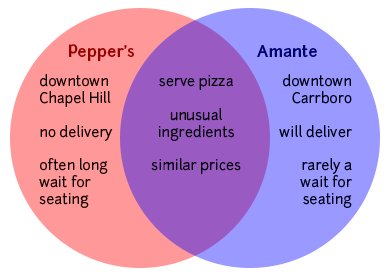
To make a chart, figure out what criteria you want to focus on in comparing the items. Along the left side of the page, list each of the criteria. Across the top, list the names of the items. You should then have a box per item for each criterion; you can fill the boxes in and then survey what you’ve discovered.
Here’s an example, this time using three pizza places:
As you generate points of comparison, consider the purpose and content of the assignment and the focus of the class. What do you think the professor wants you to learn by doing this comparison/contrast? How does it fit with what you have been studying so far and with the other assignments in the course? Are there any clues about what to focus on in the assignment itself?
Here are some general questions about different types of things you might have to compare. These are by no means complete or definitive lists; they’re just here to give you some ideas—you can generate your own questions for these and other types of comparison. You may want to begin by using the questions reporters traditionally ask: Who? What? Where? When? Why? How? If you’re talking about objects, you might also consider general properties like size, shape, color, sound, weight, taste, texture, smell, number, duration, and location.
Two historical periods or events
- When did they occur—do you know the date(s) and duration? What happened or changed during each? Why are they significant?
- What kinds of work did people do? What kinds of relationships did they have? What did they value?
- What kinds of governments were there? Who were important people involved?
- What caused events in these periods, and what consequences did they have later on?
Two ideas or theories
- What are they about?
- Did they originate at some particular time?
- Who created them? Who uses or defends them?
- What is the central focus, claim, or goal of each? What conclusions do they offer?
- How are they applied to situations/people/things/etc.?
- Which seems more plausible to you, and why? How broad is their scope?
- What kind of evidence is usually offered for them?
Two pieces of writing or art
- What are their titles? What do they describe or depict?
- What is their tone or mood? What is their form?
- Who created them? When were they created? Why do you think they were created as they were? What themes do they address?
- Do you think one is of higher quality or greater merit than the other(s)—and if so, why?
- For writing: what plot, characterization, setting, theme, tone, and type of narration are used?
- Where are they from? How old are they? What is the gender, race, class, etc. of each?
- What, if anything, are they known for? Do they have any relationship to each other?
- What are they like? What did/do they do? What do they believe? Why are they interesting?
- What stands out most about each of them?
Deciding what to focus on
By now you have probably generated a huge list of similarities and differences—congratulations! Next you must decide which of them are interesting, important, and relevant enough to be included in your paper. Ask yourself these questions:
- What’s relevant to the assignment?
- What’s relevant to the course?
- What’s interesting and informative?
- What matters to the argument you are going to make?
- What’s basic or central (and needs to be mentioned even if obvious)?
- Overall, what’s more important—the similarities or the differences?
Suppose that you are writing a paper comparing two novels. For most literature classes, the fact that they both use Caslon type (a kind of typeface, like the fonts you may use in your writing) is not going to be relevant, nor is the fact that one of them has a few illustrations and the other has none; literature classes are more likely to focus on subjects like characterization, plot, setting, the writer’s style and intentions, language, central themes, and so forth. However, if you were writing a paper for a class on typesetting or on how illustrations are used to enhance novels, the typeface and presence or absence of illustrations might be absolutely critical to include in your final paper.
Sometimes a particular point of comparison or contrast might be relevant but not terribly revealing or interesting. For example, if you are writing a paper about Wordsworth’s “Tintern Abbey” and Coleridge’s “Frost at Midnight,” pointing out that they both have nature as a central theme is relevant (comparisons of poetry often talk about themes) but not terribly interesting; your class has probably already had many discussions about the Romantic poets’ fondness for nature. Talking about the different ways nature is depicted or the different aspects of nature that are emphasized might be more interesting and show a more sophisticated understanding of the poems.
Your thesis
The thesis of your comparison/contrast paper is very important: it can help you create a focused argument and give your reader a road map so they don’t get lost in the sea of points you are about to make. As in any paper, you will want to replace vague reports of your general topic (for example, “This paper will compare and contrast two pizza places,” or “Pepper’s and Amante are similar in some ways and different in others,” or “Pepper’s and Amante are similar in many ways, but they have one major difference”) with something more detailed and specific. For example, you might say, “Pepper’s and Amante have similar prices and ingredients, but their atmospheres and willingness to deliver set them apart.”
Be careful, though—although this thesis is fairly specific and does propose a simple argument (that atmosphere and delivery make the two pizza places different), your instructor will often be looking for a bit more analysis. In this case, the obvious question is “So what? Why should anyone care that Pepper’s and Amante are different in this way?” One might also wonder why the writer chose those two particular pizza places to compare—why not Papa John’s, Dominos, or Pizza Hut? Again, thinking about the context the class provides may help you answer such questions and make a stronger argument. Here’s a revision of the thesis mentioned earlier:
Pepper’s and Amante both offer a greater variety of ingredients than other Chapel Hill/Carrboro pizza places (and than any of the national chains), but the funky, lively atmosphere at Pepper’s makes it a better place to give visiting friends and family a taste of local culture.
You may find our handout on constructing thesis statements useful at this stage.
Organizing your paper
There are many different ways to organize a comparison/contrast essay. Here are two:
Subject-by-subject
Begin by saying everything you have to say about the first subject you are discussing, then move on and make all the points you want to make about the second subject (and after that, the third, and so on, if you’re comparing/contrasting more than two things). If the paper is short, you might be able to fit all of your points about each item into a single paragraph, but it’s more likely that you’d have several paragraphs per item. Using our pizza place comparison/contrast as an example, after the introduction, you might have a paragraph about the ingredients available at Pepper’s, a paragraph about its location, and a paragraph about its ambience. Then you’d have three similar paragraphs about Amante, followed by your conclusion.
The danger of this subject-by-subject organization is that your paper will simply be a list of points: a certain number of points (in my example, three) about one subject, then a certain number of points about another. This is usually not what college instructors are looking for in a paper—generally they want you to compare or contrast two or more things very directly, rather than just listing the traits the things have and leaving it up to the reader to reflect on how those traits are similar or different and why those similarities or differences matter. Thus, if you use the subject-by-subject form, you will probably want to have a very strong, analytical thesis and at least one body paragraph that ties all of your different points together.
A subject-by-subject structure can be a logical choice if you are writing what is sometimes called a “lens” comparison, in which you use one subject or item (which isn’t really your main topic) to better understand another item (which is). For example, you might be asked to compare a poem you’ve already covered thoroughly in class with one you are reading on your own. It might make sense to give a brief summary of your main ideas about the first poem (this would be your first subject, the “lens”), and then spend most of your paper discussing how those points are similar to or different from your ideas about the second.
Point-by-point
Rather than addressing things one subject at a time, you may wish to talk about one point of comparison at a time. There are two main ways this might play out, depending on how much you have to say about each of the things you are comparing. If you have just a little, you might, in a single paragraph, discuss how a certain point of comparison/contrast relates to all the items you are discussing. For example, I might describe, in one paragraph, what the prices are like at both Pepper’s and Amante; in the next paragraph, I might compare the ingredients available; in a third, I might contrast the atmospheres of the two restaurants.
If I had a bit more to say about the items I was comparing/contrasting, I might devote a whole paragraph to how each point relates to each item. For example, I might have a whole paragraph about the clientele at Pepper’s, followed by a whole paragraph about the clientele at Amante; then I would move on and do two more paragraphs discussing my next point of comparison/contrast—like the ingredients available at each restaurant.
There are no hard and fast rules about organizing a comparison/contrast paper, of course. Just be sure that your reader can easily tell what’s going on! Be aware, too, of the placement of your different points. If you are writing a comparison/contrast in service of an argument, keep in mind that the last point you make is the one you are leaving your reader with. For example, if I am trying to argue that Amante is better than Pepper’s, I should end with a contrast that leaves Amante sounding good, rather than with a point of comparison that I have to admit makes Pepper’s look better. If you’ve decided that the differences between the items you’re comparing/contrasting are most important, you’ll want to end with the differences—and vice versa, if the similarities seem most important to you.
Our handout on organization can help you write good topic sentences and transitions and make sure that you have a good overall structure in place for your paper.
Cue words and other tips
To help your reader keep track of where you are in the comparison/contrast, you’ll want to be sure that your transitions and topic sentences are especially strong. Your thesis should already have given the reader an idea of the points you’ll be making and the organization you’ll be using, but you can help them out with some extra cues. The following words may be helpful to you in signaling your intentions:
- like, similar to, also, unlike, similarly, in the same way, likewise, again, compared to, in contrast, in like manner, contrasted with, on the contrary, however, although, yet, even though, still, but, nevertheless, conversely, at the same time, regardless, despite, while, on the one hand … on the other hand.
For example, you might have a topic sentence like one of these:
- Compared to Pepper’s, Amante is quiet.
- Like Amante, Pepper’s offers fresh garlic as a topping.
- Despite their different locations (downtown Chapel Hill and downtown Carrboro), Pepper’s and Amante are both fairly easy to get to.
You may reproduce it for non-commercial use if you use the entire handout and attribute the source: The Writing Center, University of North Carolina at Chapel Hill
Make a Gift
Comparing and Contrasting: A Guide to Improve Your Essays

By Walter Akolo
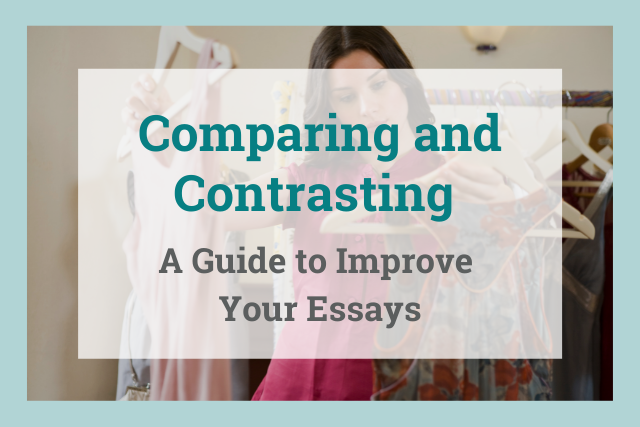
Essays that require you to compare and contrast two or more subjects, ideas, places, or items are common.
They call for you to highlight the key similarities (compare) and differences (contrast) between them.
This guide contains all the information you need to become better at writing comparing and contrasting essays.
This includes: how to structure your essay, how to decide on the content, and some examples of essay questions.
Let’s dive in.
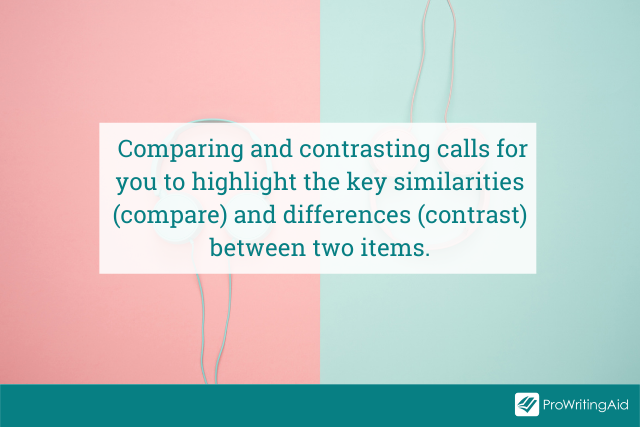
What Is Comparing and Contrasting?
Is compare and contrast the same as similarities and differences, what is the purpose of comparing and contrasting, can you compare and contrast any two items, how do you compare and contrast in writing, what are some comparing and contrasting techniques, how do you compare and contrast in college level writing, the four essentials of compare and contrast essays, what can you learn from a compare and contrast essay.
At their most basic, both comparing and contrasting base their evaluation on two or more subjects that share a connection.
The subjects could have similar characteristics, features, or foundations.
But while a comparison discusses the similarities of the two subjects, e.g. a banana and a watermelon are both fruit, contrasting highlights how the subjects or items differ from each other, e.g. a watermelon is around 10 times larger than a banana.
Any question that you are asked in education will have a variety of interesting comparisons and deductions that you can make.
Compare is the same as similarities.
Contrast is the same as differences.
This is because comparing identifies the likeness between two subjects, items, or categories, while contrasting recognizes disparities between them.
When you compare things, you represent them regarding their similarity, but when you contrast things, you define them in reference to their differences.
As a result, if you are asked to discuss the similarities and differences between two subjects, you can take an identical approach to if you are writing a compare and contrast essay.
In writing, the purpose of comparing and contrasting is to highlight subtle but important differences or similarities that might not be immediately obvious.
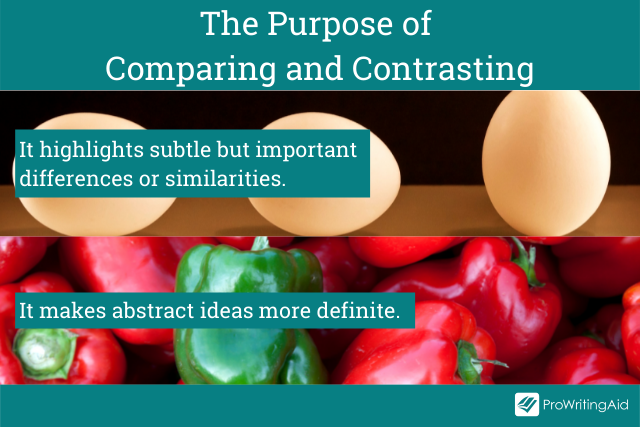
By illustrating the differences between elements in a similar category, you help heighten readers’ understanding of the subject or topic of discussion.
For instance, you might choose to compare and contrast red wine and white wine by pointing out the subtle differences. One of these differences is that red wine is best served at room temperature while white is best served chilled.
Also, comparing and contrasting helps to make abstract ideas more definite and minimizes the confusion that might exist between two related concepts.
Can Comparing and Contrasting Be Useful Outside of Academia?
Comparing enables you to see the pros and cons, allowing you to have a better understanding of the things under discussion. In an essay, this helps you demonstrate that you understand the nuances of your topic enough to draw meaningful conclusions from them.
Let's use a real-word example to see the benefits. Imagine you're contrasting two dresses you could buy. You might think:
- Dress A is purple, my favorite color, but it has a difficult zip and is practically impossible to match a jacket to.
- Dress B is more expensive but I already have a suitable pair of shoes and jacket and it is easier to move in.
You're linking the qualities of each dress to the context of the decision you're making. This is the same for your essay. Your comparison and contrast points will be in relation to the question you need to answer.
Comparing and contrasting is only a useful technique when applied to two related concepts.
To effectively compare two or more things, they must feature characteristics similar enough to warrant comparison.
In addition to this they must also feature a similarity that generates an interesting discussion. But what do I mean by “interesting” here?
Let’s look at two concepts, the Magna Carta and my third grade poetry competition entry.
They are both text, written on paper by a person so they fulfil the first requirement, they have a similarity. But this comparison clearly would not fulfil the second requirement, you would not be able to draw any interesting conclusions.
However, if we compare the Magna Carta to the Bill of Rights, you would be able to come to some very interesting conclusions concerning the history of world politics.
To write a good compare and contrast essay, it’s best to pick two or more topics that share a meaningful connection .
The aim of the essay would be to show the subtle differences or unforeseen similarities.
By highlighting the distinctions between elements in a similar category you can increase your readers’ understanding.
Alternatively, you could choose to focus on a comparison between two subjects that initially appear unrelated.
The more dissimilar they seem, the more interesting the comparison essay will turn out.
For instance, you could compare and contrast professional rugby players with marathon runners.
Can You Compare and Contrast in an Essay That Does Not Specifically Require It?
As a writer, you can employ comparing and contrasting techniques in your writing, particularly when looking for ideas you can later apply in your argument.
You can do this even when the comparison or contrast is not a requirement for the topic or argument you are presenting. Doing so could enable you to build your evaluation and develop a stronger argument.
Note that the similarities and differences you come up with might not even show up in the final draft.
While the use of compare and contrast can be neutral, you can also use it to highlight one option under discussion. When used this way, you can influence the perceived advantages of your preferred option.
As a writing style, comparing and contrasting can encompass an entire essay. However, it could also appear in some select paragraphs within the essay, where making some comparisons serves to better illustrate a point.
What Should You Do First?
Before you compare two things, always start by deciding on the reason for your comparison, then outline the criteria you will use to compare them.
Words and phrases commonly used for comparison include:

In writing, these words and phrases are called transitions . They help readers to understand or make the connection between sentences, paragraphs, and ideas.
Without transition words writing can feel clumsy and disjointed making it difficult to read. ProWritingAid’s transition report highlights all of a documents transitions and suggests that 25% of any sentences in a piece include a transition.

Sign up for a free ProWritingAid account to use the Transitions Report.
So, how do you form all of this into a coherent essay? It's a good idea to plan first, then decide what your paragraph layout will look like.
Venn diagrams are useful tool to start generating ideas. The, for your essay, you need to choose between going idea by idea and going point by point.
Using a Venn Diagram
A Venn diagram helps you to clearly see the similarities and differences between multiple objects, things, or subjects.
The writing tool comprises two, or more, simple, overlapping circles in which you list down the things that are alike (within the overlapping area) and those that differ (outside the overlapping area).
It’s great for brainstorming ideas and for creating your essay’s outline. You could even use it in an exam setting because it is quick and simple.
Going Subject by Subject
Going subject by subject is a structural choice for your essay.
Start by saying all you have to say on the first subject, then proceed to do the same about the second subject.
Depending on the length of your essay, you can fit the points about each subject into one paragraph or have several sections per each subject, ending with a conclusion.
This method is best for short essays on simple topics. Most university-level essays will go point by point instead.
Going Point by Point
Going point by point, or alternating, is the opposite essay structure from going subject by subject. This is ideal when you want to do more direct comparing and contrasting. It entails discussing one comparison point at a time. It allows you to use a paragraph to talk about how a certain comparing/contrasting point relates to the subjects or items you are discussing.
Alternatively, if you have lots of details about the subject, you might decide to use a paragraph for each point.
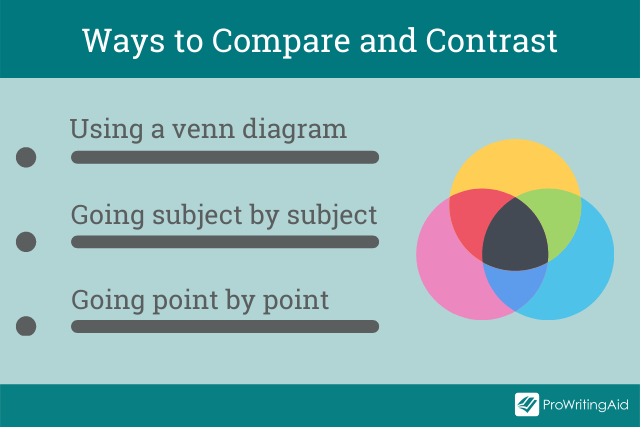
An academic compare and contrast essay looks at two or more subjects, ideas, people, or objects, compares their likeness, and contrasts their differences.
It’s an informative essay that provides insights on what is similar and different between the two items.
Depending on the essay’s instructions, you can focus solely on comparing or contrasting, or a combination of the two.
Examples of College Level Compare and Contrast Essay Questions
Here are eleven examples of compare and contrast essay questions that you might encounter at university:

- Archaeology: Compare and contrast the skulls of homo habilis, homo erectus, and homo sapiens.
- Art: Compare and contrast the working styles of any two Neoclassic artists.
- Astrophysics: Compare and contrast the chemical composition of Venus and Neptune.
- Biology: Compare and contrast the theories of Lamarck and Darwin.
- Business: Compare and contrast 2 or more business models within the agricultural industry.
- Creative writing: Compare and contrast free indirect discourse with epistolary styles.
- English Literature: Compare and contrast William Wordsworth with Robert Browning.
- Geography: Compare and contrast the benefit of solar panels with the benefit of wind turbines.
- History: Compare and contrast WWI to WWII with specific reference to the causes and outcomes.
- Medicine: Compare and contrast England’s health service with America’s health service.
- Psychology: Compare and contrast the behaviorist theory with the psychodynamic theory.
So, the key takeaways to keep in mind are:
Have a basis for comparison. The two things need to have enough in common to justify a discussion about their similarities and disparities.
Don’t go back and forth when using the block method. The best way to write your essay is to begin with a paragraph discussing all the facets of the first topic. Then, move on to another paragraph and talk through all the aspects of the second subject.
You can use both alternating and blocking techniques. Combining the two approaches is also an option. You can apply the alternating method in some paragraphs, then switch and use the block method. This method will help you offer a much deeper analysis of the subjects.
Have a reason for comparing the two things. Only select the points of comparison that resonate with your purpose.
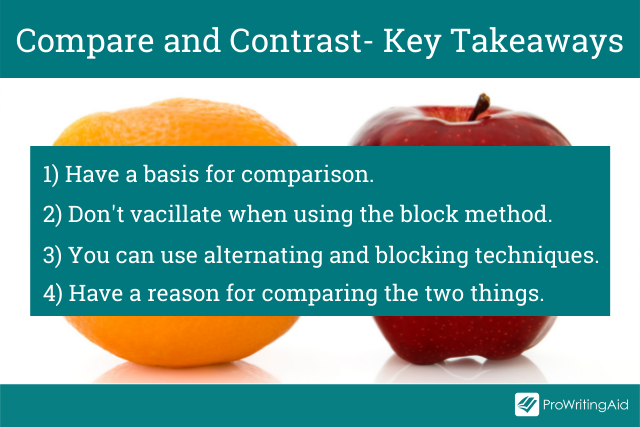
Comparing and contrasting are essential analytical skills in academic writing. When your professor issues you with such an essay, their primary goal is to teach you how to:
- Engage in critical thinking
- See and make connections between words or ideas
- Move beyond mere descriptions or summaries to developing interesting analysis
- Get a deeper understanding of the subjects or items under comparison, their key features, and their interrelationships with each other.
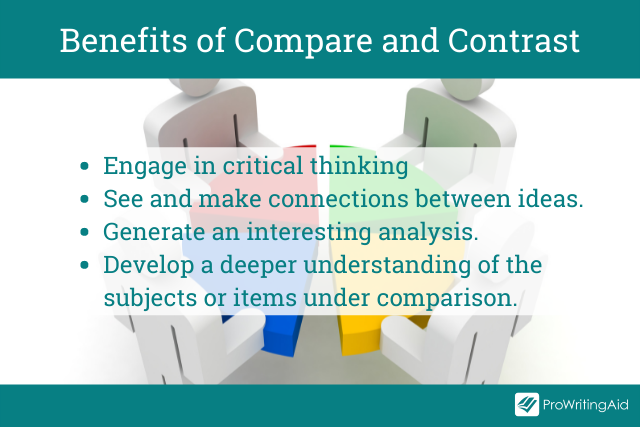
Ultimately, your essay should enlighten readers by providing useful information.
Want to use ProWritingAid with your classroom? Download this free book now:

ProWritingAid Teacher’s Manual
Editing technology like prowritingaid provides immediate, personalized feedback that will help students to better understand grammar and writing techniques., in this guide , we walk you through exactly how to use prowritingaid in your classroom and give you tools and templates for creating a rigorous, effective independent writing practice with your students..

Be confident about grammar
Check every email, essay, or story for grammar mistakes. Fix them before you press send.
Walter Akolo
Walter Akolo is a freelance writer, internet marketer, trainer, and blogger for hire. He loves helping businesses increase their reach and conversion through excellent and engaging content. He has gotten millions of pageviews on his blog, FreelancerKenya, where he mentors writers. Check out his website walterakolo.com.
Get started with ProWritingAid
Drop us a line or let's stay in touch via:

IMAGES
VIDEO
COMMENTS
Compare and contrast transition words for essays, discussions and more. When you are trying to compare and contrast different things, it helps to have the right words and phrases to explain your ideas clearly. This is where compare and contrast transition words come in handy.
A compare-and-contrast essay is a style of essay that points out the similarities and differences between two or more subjects. It’s ideal… Learn how to write a stronger-than-ever compare-and-contrast essay, with tips and examples to help you organize your ideas.
Some essay prompts include the keywords “compare” and/or “contrast.” In these cases, an essay structured around comparing and contrasting is the appropriate response.
5 Compare and Contrast Essay Examples (Full Text) A compare and contrast essay selects two or more items that are critically analyzed to demonstrate their differences and similarities. Here is a template for you that provides the general structure: A range of example essays is presented below.
One of the most common is the comparison/contrast essay, in which you focus on the ways in which certain things or ideas—usually two of them—are similar to (this is the comparison) and/or different from (this is the contrast) one another.
To write a good compare and contrast essay, it’s best to pick two or more topics that share a meaningful connection. The aim of the essay would be to show the subtle differences or unforeseen similarities.